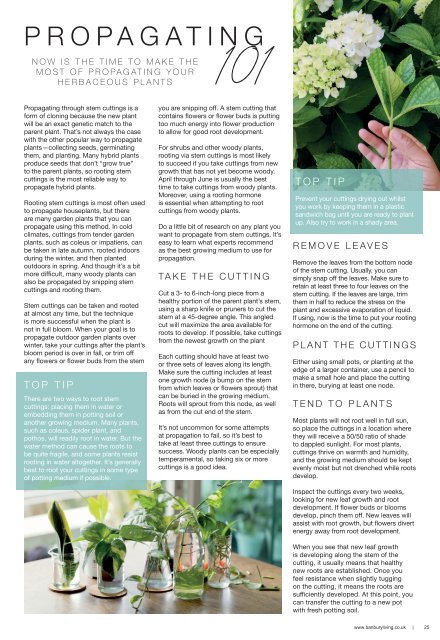Banbury Living Oct - Nov 2022
The October/November edition is here! We start ramping up for winter with some festive home tips and bonfire night recipes, as well as a whole host of fabulous competitions.
The October/November edition is here! We start ramping up for winter with some festive home tips and bonfire night recipes, as well as a whole host of fabulous competitions.
You also want an ePaper? Increase the reach of your titles
YUMPU automatically turns print PDFs into web optimized ePapers that Google loves.
PROPAGATING<br />
NOW IS THE TIME TO MAKE THE<br />
MOST OF PROPAGATING YOUR<br />
HERBACEOUS PLANTS<br />
101<br />
Propagating through stem cuttings is a<br />
form of cloning because the new plant<br />
will be an exact genetic match to the<br />
parent plant. That’s not always the case<br />
with the other popular way to propagate<br />
plants—collecting seeds, germinating<br />
them, and planting. Many hybrid plants<br />
produce seeds that don’t “grow true”<br />
to the parent plants, so rooting stem<br />
cuttings is the most reliable way to<br />
propagate hybrid plants.<br />
Rooting stem cuttings is most often used<br />
to propagate houseplants, but there<br />
are many garden plants that you can<br />
propagate using this method. In cold<br />
climates, cuttings from tender garden<br />
plants, such as coleus or impatiens, can<br />
be taken in late autumn, rooted indoors<br />
during the winter, and then planted<br />
outdoors in spring. And though it’s a bit<br />
more difficult, many woody plants can<br />
also be propagated by snipping stem<br />
cuttings and rooting them.<br />
Stem cuttings can be taken and rooted<br />
at almost any time, but the technique<br />
is more successful when the plant is<br />
not in full bloom. When your goal is to<br />
propagate outdoor garden plants over<br />
winter, take your cuttings after the plant’s<br />
bloom period is over in fall, or trim off<br />
any flowers or flower buds from the stem<br />
TOP TIP<br />
There are two ways to root stem<br />
cuttings: placing them in water or<br />
embedding them in potting soil or<br />
another growing medium. Many plants,<br />
such as coleus, spider plant, and<br />
pothos, will readily root in water. But the<br />
water method can cause the roots to<br />
be quite fragile, and some plants resist<br />
rooting in water altogether. It’s generally<br />
best to root your cuttings in some type<br />
of potting medium if possible.<br />
you are snipping off. A stem cutting that<br />
contains flowers or flower buds is putting<br />
too much energy into flower production<br />
to allow for good root development.<br />
For shrubs and other woody plants,<br />
rooting via stem cuttings is most likely<br />
to succeed if you take cuttings from new<br />
growth that has not yet become woody.<br />
April through June is usually the best<br />
time to take cuttings from woody plants.<br />
Moreover, using a rooting hormone<br />
is essential when attempting to root<br />
cuttings from woody plants.<br />
Do a little bit of research on any plant you<br />
want to propagate from stem cuttings. It’s<br />
easy to learn what experts recommend<br />
as the best growing medium to use for<br />
propagation.<br />
TAKE THE CUTTING<br />
Cut a 3- to 6-inch-long piece from a<br />
healthy portion of the parent plant’s stem,<br />
using a sharp knife or pruners to cut the<br />
stem at a 45-degree angle. This angled<br />
cut will maximize the area available for<br />
roots to develop. If possible, take cuttings<br />
from the newest growth on the plant<br />
Each cutting should have at least two<br />
or three sets of leaves along its length.<br />
Make sure the cutting includes at least<br />
one growth node (a bump on the stem<br />
from which leaves or flowers sprout) that<br />
can be buried in the growing medium.<br />
Roots will sprout from this node, as well<br />
as from the cut end of the stem.<br />
It’s not uncommon for some attempts<br />
at propagation to fail, so it’s best to<br />
take at least three cuttings to ensure<br />
success. Woody plants can be especially<br />
temperamental, so taking six or more<br />
cuttings is a good idea.<br />
TOP TIP<br />
Prevent your cuttings drying out whilst<br />
you work by keeping them in a plastic<br />
sandwich bag until you are ready to plant<br />
up. Also try to work in a shady area.<br />
REMOVE LEAVES<br />
Remove the leaves from the bottom node<br />
of the stem cutting. Usually, you can<br />
simply snap off the leaves. Make sure to<br />
retain at least three to four leaves on the<br />
stem cutting. If the leaves are large, trim<br />
them in half to reduce the stress on the<br />
plant and excessive evaporation of liquid.<br />
If using, now is the time to put your rooting<br />
hormone on the end of the cutting.<br />
PLANT THE CUTTINGS<br />
Either using small pots, or planting at the<br />
edge of a larger container, use a pencil to<br />
make a small hole and place the cutting<br />
in there, burying at least one node.<br />
TEND TO PLANTS<br />
Most plants will not root well in full sun,<br />
so place the cuttings in a location where<br />
they will receive a 50/50 ratio of shade<br />
to dappled sunlight. For most plants,<br />
cuttings thrive on warmth and humidity,<br />
and the growing medium should be kept<br />
evenly moist but not drenched while roots<br />
develop.<br />
Inspect the cuttings every two weeks,<br />
looking for new leaf growth and root<br />
development. If flower buds or blooms<br />
develop, pinch them off. New leaves will<br />
assist with root growth, but flowers divert<br />
energy away from root development.<br />
When you see that new leaf growth<br />
is developing along the stem of the<br />
cutting, it usually means that healthy<br />
new roots are established. Once you<br />
feel resistance when slightly tugging<br />
on the cutting, it means the roots are<br />
sufficiently developed. At this point, you<br />
can transfer the cutting to a new pot<br />
with fresh potting soil.<br />
www.banburyliving.co.uk | 25


















